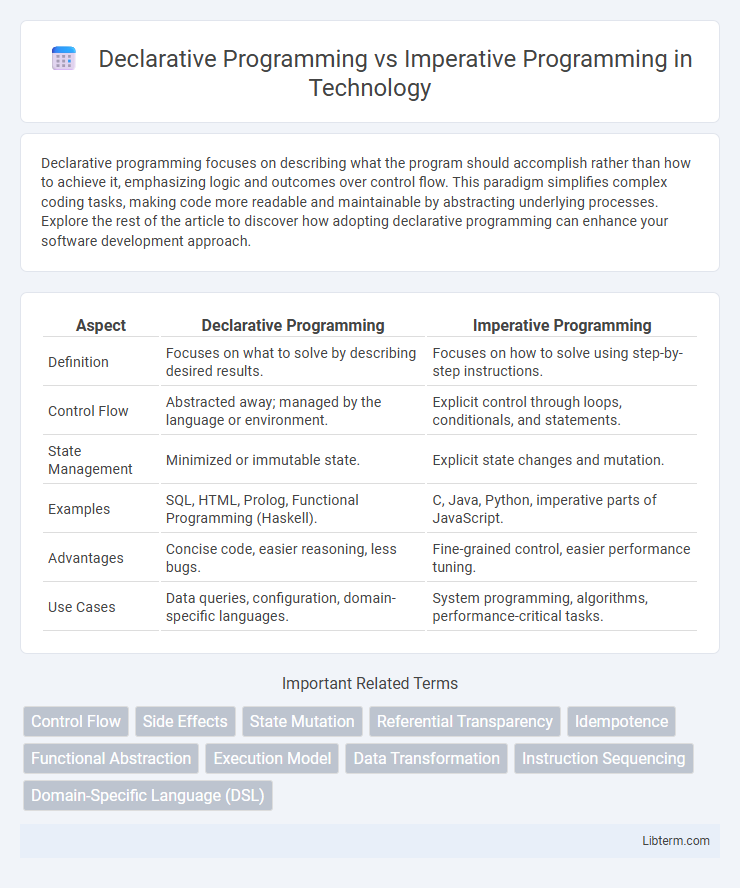Declarative programming focuses on describing what the program should accomplish rather than how to achieve it, emphasizing logic and outcomes over control flow. This paradigm simplifies complex coding tasks, making code more readable and maintainable by abstracting underlying processes. Explore the rest of the article to discover how adopting declarative programming can enhance your software development approach.
Table of Comparison
| Aspect | Declarative Programming | Imperative Programming |
|---|---|---|
| Definition | Focuses on what to solve by describing desired results. | Focuses on how to solve using step-by-step instructions. |
| Control Flow | Abstracted away; managed by the language or environment. | Explicit control through loops, conditionals, and statements. |
| State Management | Minimized or immutable state. | Explicit state changes and mutation. |
| Examples | SQL, HTML, Prolog, Functional Programming (Haskell). | C, Java, Python, imperative parts of JavaScript. |
| Advantages | Concise code, easier reasoning, less bugs. | Fine-grained control, easier performance tuning. |
| Use Cases | Data queries, configuration, domain-specific languages. | System programming, algorithms, performance-critical tasks. |
Introduction to Programming Paradigms
Declarative programming emphasizes what the program should accomplish by describing desired results, often using languages like SQL or functional languages such as Haskell. Imperative programming focuses on how to achieve tasks through explicit statements that change program state, commonly seen in languages like C, Java, or Python. Understanding these contrasting programming paradigms helps developers choose appropriate approaches for problem-solving and software design.
What is Declarative Programming?
Declarative programming is a paradigm that expresses the logic of computation without describing its control flow, focusing on what the program should accomplish rather than how to achieve it. It utilizes high-level constructs such as expressions and declarations to define desired outcomes, often seen in languages like SQL and HTML. This approach enhances code readability, maintainability, and allows for easier parallelization by abstracting the underlying implementation details.
What is Imperative Programming?
Imperative programming is a programming paradigm that focuses on explicitly defining the steps a computer must take to achieve a desired outcome by modifying program state through statements and control structures like loops and conditionals. It requires detailed instructions on how to perform a task, emphasizing the sequence of operations and how data changes over time. Languages such as C, Java, and Python support imperative programming by enabling developers to write code that directs the computer's behavior step-by-step.
Key Differences Between Declarative and Imperative Approaches
Declarative programming emphasizes what the program should accomplish by describing desired outcomes without explicitly detailing the control flow, while imperative programming focuses on how to achieve those outcomes using specific step-by-step instructions and state changes. Key differences include declarative programming's higher abstraction level, leading to more concise and readable code, and imperative programming's explicit control over program state and execution order, which can offer greater flexibility and performance optimization. Popular declarative paradigms include functional and logic programming, whereas imperative paradigms encompass procedural and object-oriented programming styles.
Real-World Examples of Declarative Programming
Declarative programming languages like SQL and HTML enable developers to specify what results they want without detailing the control flow, making them ideal for database queries and web page structuring. Tools such as React use declarative paradigms to efficiently update user interfaces by describing the desired state rather than explicit DOM manipulations. These real-world applications highlight how declarative programming enhances code readability, maintainability, and abstraction in complex software systems.
Real-World Examples of Imperative Programming
Imperative programming is exemplified by languages like C, Java, and Python, which focus on explicit step-by-step instructions to manipulate program state. Real-world applications such as operating systems development, game programming, and embedded systems rely heavily on imperative paradigms for precise control over hardware and system resources. This programming style excels in scenarios where detailed manipulation of memory and system processes is crucial for performance and responsiveness.
Advantages of Declarative Programming
Declarative programming enhances code readability and maintainability by focusing on what needs to be achieved rather than detailing how to perform tasks, reducing complexity for developers. It facilitates easier debugging and testing since the code expresses logic without explicitly managing state or control flow, enabling more predictable outcomes. Additionally, declarative paradigms support parallelism and optimization by abstracting execution details, allowing modern compilers and runtimes to improve performance automatically.
Advantages of Imperative Programming
Imperative programming offers precise control over program state and execution flow, enabling efficient memory management and optimization for performance-critical applications. Its step-by-step command structure is intuitive for developers, facilitating easier debugging and understanding of program behavior. This approach is highly compatible with hardware architecture, resulting in faster execution compared to declarative paradigms in many use cases.
When to Use Declarative vs Imperative Programming
Declarative programming is ideal for scenarios where the desired outcome is prioritized over the specific steps to achieve it, such as in database queries with SQL or UI development with React, enabling more concise and readable code. Imperative programming suits applications requiring detailed control over state and performance optimization, like system programming or algorithms with complex control flows. Choosing between them depends on the problem domain: use declarative styles when abstraction and maintainability matter, and imperative when fine-grained control and efficiency are critical.
Conclusion: Choosing the Right Paradigm
Selecting between declarative and imperative programming hinges on project requirements and developer goals. Declarative programming excels in expressing complex logic with less code, enhancing readability and maintainability, especially in database queries and UI design. Imperative programming provides fine-grained control over system state and performance, making it ideal for low-level programming and real-time applications.
Declarative Programming Infographic

 libterm.com
libterm.com